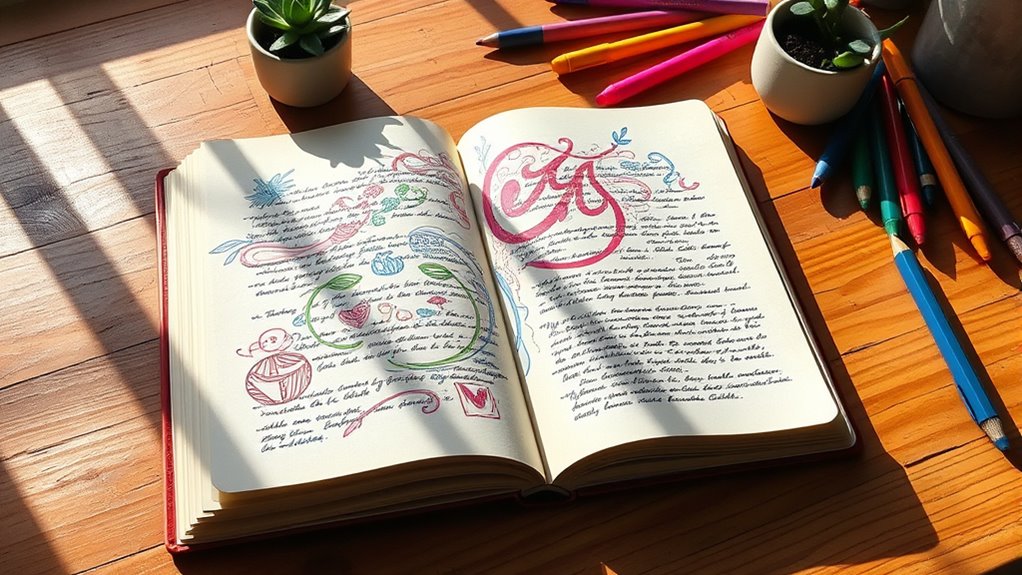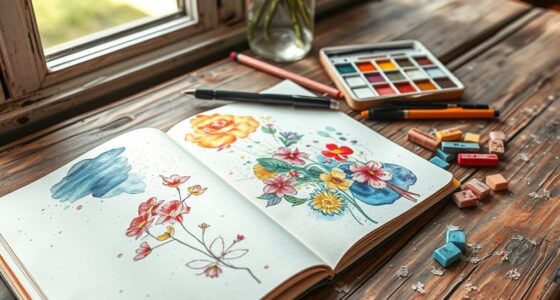By incorporating creative journaling into your daily routine, you can effectively boost emotional well-being through expressive writing, visual art, and mindfulness techniques. It allows you to release thoughts, process emotions, and stay present, creating a calming and safe space for honest reflection. This flexible practice supports personal growth and emotional resilience, helping you identify patterns and breakthroughs over time. Keep exploring, and you’ll discover even more ways to deepen this empowering habit.
Key Takeaways
- Establish a daily routine to foster consistency and deepen self-awareness through creative expression.
- Incorporate mindfulness techniques like breath awareness before journaling to enhance emotional clarity.
- Use visual elements such as sketches or collages to access subconscious feelings and promote emotional release.
- Emphasize authenticity over perfection to create a safe space for honest reflection and personal growth.
- Recognize patterns and insights over time, supporting resilience and emotional well-being through regular practice.

Have you ever considered how creative journaling can release your inner thoughts and inspire new ideas? It’s a powerful way to connect with yourself, process emotions, and foster personal growth. When you sit down with your journal each day, you’re not just writing words—you’re engaging in mindfulness techniques that anchor you in the present moment. These practices help you become aware of your feelings without judgment, allowing you to explore your inner landscape with clarity. As you focus on your breath, sensations, or simply observe your thoughts, you create a calming space that encourages honest reflection. This mindful approach makes journaling more than just a task; it transforms it into a therapeutic ritual that nurtures your emotional well-being. Incorporating nutritional information into your routine can also support your overall mental health and resilience.
Incorporating visual expression into your journaling practice can take it even deeper. Don’t worry about artistic skill—this isn’t about creating perfect drawings or images but about expressing what words sometimes can’t capture. You might doodle your feelings, sketch symbols that resonate with your mood, or collage images from magazines that represent your aspirations or challenges. Visual expression taps into your subconscious and helps you process complex emotions more intuitively. It invites you to see your thoughts from different angles, encouraging creativity and self-discovery. When you combine visual elements with written words, you create a rich, multi-layered record of your inner world. This approach not only makes journaling more engaging but also enhances your ability to understand and manage your emotions.
The beauty of creative journaling lies in its flexibility. You can set aside a few minutes each day or plunge into it whenever you need a mental reset. It’s not about producing perfect pages but about showing up authentically. Use your journal as a safe space to experiment with mindfulness techniques, such as deep breathing or body scans, before you start writing or drawing. These techniques help you clear your mind and focus on what truly matters to you in that moment. Over time, you’ll notice patterns, insights, and breakthroughs emerge from your daily practice. Your journal becomes a personal sanctuary—an ongoing dialogue with yourself that fosters emotional resilience, clarity, and inspiration. So, pick up that pen, grab some supplies, and let your creativity flow freely.
Frequently Asked Questions
Can Creative Journaling Replace Therapy?
Creative journaling can’t replace therapy, but it offers significant therapeutic benefits, like helping you process emotions and achieve emotional release. It serves as a valuable self-care tool, allowing you to explore your feelings in a safe space. However, if you’re dealing with severe mental health issues, professional therapy provides tailored support that journaling alone can’t offer. Use journaling as a complementary practice to enhance your emotional well-being.
What Materials Are Best for Beginners?
Are you wondering what materials suit beginners? You’ll want simple art supplies like pens, colored pencils, and markers to start. A plain notebook or sketchbook works well for journaling techniques, allowing you to freely express yourself. Keep it straightforward—no need for fancy tools. The key is to focus on your feelings and ideas rather than perfecting your art, making these materials perfect for building your creative journaling practice.
How Long Should I Journal Daily?
You should aim for about 10 to 15 minutes of journaling daily. This journaling duration allows you to maintain daily consistency without feeling overwhelmed. Consistency matters more than length, so even a few minutes each day helps build a habit that boosts emotional well-being. Stick to this routine, and over time, you’ll notice it becoming a valuable part of your daily self-care practice.
Is There a Risk of Emotional Overwhelm?
Like walking a tightrope, journaling can sometimes lead to emotional overload if you’re not careful. Yes, there’s a risk of feeling overwhelmed, but setting clear journaling boundaries helps prevent this. You control what you share and how deep you go, protecting yourself from emotional overwhelm. Take breaks when needed, and remember, journaling should uplift, not drain you. Keep it balanced, and it remains a safe space for reflection.
Can Creative Journaling Improve Relationships?
Yes, creative journaling can improve your relationships by encouraging emotional expression and fostering insight into your feelings and behaviors. As you write, you gain clarity about your emotions, which helps you communicate more effectively and empathetically with others. This process deepens your understanding of relationship dynamics and boosts connection. Regular journaling makes you more self-aware, enabling you to navigate conflicts better and build stronger, more authentic bonds.
Conclusion
By embracing creative journaling daily, you plant seeds of self-awareness that blossom over time. Think of it as tending a garden—you might start with a single, tiny sprout, but with patience and care, it grows into a vibrant, nourishing sanctuary. Just like Sarah, who found clarity through her sketches and words, your consistent effort can turn everyday chaos into a peaceful oasis. Keep writing, and watch your emotional well-being flourish.









